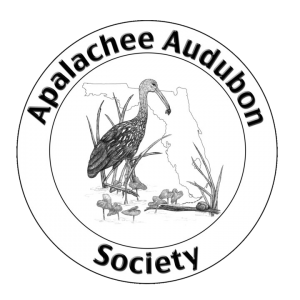Tallahassee CARES Community Resource Expo, South City
By Elizabeth Platt
Peter Kleinhenz helps kids play the migration game. Photo by Elizabeth Platt
The day was sparkling as we arrived at 8:30 to set up the Audubon display tables along Polk Street in front of the I-Grow Community Garden which faces Orange Avenue to the south. Devoted largely to the growing of vegetables by the Tallahassee Food Network, the garden is also the site of a 120 square foot pollinator garden planted by owners and staff of Native Nurseries, and funded by Apalachee Audubon. This garden, maintained by the garden team and a few neighbors, has been the learning focus of a small number of children from the neighborhood; each of the 20 native plants in the garden will attract the specific insect with which it has co-evolved, and will in turn begin bringing birds to feed on the insects.
There were two sites for the Audubon display, the first of which was at the garden where creative, fun, and educational hands-on activities were supervised by Betsy Sullivan, Laurie Jones, Dee Wilder, and Peter Kleinhenz. Betsy had created a matching game with eight pictures of birds, each of which had a different kind of beak, eight tools each corresponding to the function of one of the beaks, and eight representations of food that would be eaten by one of the eight birds. For example, the hummingbird’s beak performs the function of a straw, and the straw would be used to take nectar from a flower. Environmental educator and board member, Peter Kleinhenz had brought a migration game, consisting of a map of North America with migratory flyways indicated, several colored rings that each represented a wildlife refuge, and bean bags representing birds that would be migrating along one of the NA flyways. The object was for a child to toss a bean bag into a ring. The learning objective was for kids to understand that the location of the refuges with respect to each other is crucial to the survival of the birds during migration.
Elizabeth, Peter, and Norma work on installing a bluebird box in the garden.
Laurie, a science teacher like Betsy, and Dee Wilder, grant writer who helped conceptualize the multi-faceted project that led to the Expo, assisted Betsy and Peter, and helped visitors when they arrived at their station. Norma Woodcock, supervisor of the I-Grow garden and steward of the pollinator garden as well, was with us all day, giving tours of the I-Grow garden and talking to visitors. Later in the day Judy Goldman came to help, and Lily Anderson from Native Nurseries, also an AAS board member, arrived with a small display of plants and helpful literature. She and Peter later erected a bird box and baffle at the east end of the larger garden. During the digging Peter encountered an eastern spadefoot toad, an unusual animal that emerges from deep underground only once a year to breed. It was quite an exciting moment!
Pat and Carol educate kids and adults about Apalachee Audubon activities.
The other Audubon area consisted of two tables down Polk Street closer to the other exhibits. There Pat Press and Carol Franchi, AAS board and education committee members, established their display of books, the most popular of which is one that shows a picture of a bird associated with its call or song. They, too, had a number of brochures and bookmarks with the AAS web address to distribute as they chatted with visitors. AAS President Budd Titlow, Elizabeth Platt, expo event coordinator for AAS, and Christina Mbuya, FAMU environmental studies graduate student, assisted, engaging visitors in conversations about birds seen in their neighborhood. At that location were two posters that had been made by youngsters in the neighborhood shortly before the Expo, one illustrating the native plant, insect, bird connection, and the other displaying several common birds they might see in South City.
What we learned during the expo is that South City people are indeed interested in the natural world around them, are often dedicated gardeners, and openly welcomed AAS to their neighborhood. I believe participants thought the day was well-spent, and that the neighborhood should remain a focus of AAS. There are willing ears and hearts interested in the message of good stewardship of our precious environment and the creatures who inhabit it with us.



